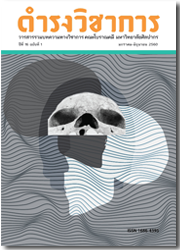Beliefs of the Poet Praising the Kings reflected from the Kavisamaya : A Study of Sanskrit Inscriptions found in Thailand
Keywords:
Beliefs of the Poets, Praising the Kings, Kavisamaya (convention of the poet), Sanskrit inscriptions found in ThailandAbstract
This paper aims to study thebeliefs of the poet’s praising of the kings through the poetic convention or kavisamaya.The samples were 7 Sanskrit Inscriptions found in Thailand (1) Wat-Sema-Mueang Inscription, (2) Sdokkok-Thom II Inscription, (3) Prasat-Thap-Siam II Inscription, (4) Prasat-Phnom-Rung Inscription, (5) Prasat-Ta-Mian-Tot Inscription, (6) Wat-Hua-Weang-Mueang-Chaiya I Inscription, (7) Mueang-sema Inscription. From the study, it is found that there were 10 kinds of belief regarding to the kavisamaya for praising the kings: (1) Brahman was the creator of the kings; (2) the glory of the kings pervades infinitely; (3) thekings were as powerful as the sun; (4) the kings were as beautiful as the moon; (5) the kings had the same features as the moon and the sun; (6) the kings were as beautiful as or more than Kāmadeva (god of love); (7) Goddess Lakṣmī had a close relationship with the kings; (8) thekings were omniscient; (9) the great kings’ feet were honored by other kings; (10) the kings were associated with gigantic or magical trees. It was found that the poets who praised the kings believed that the kings’ image was different from other normal people: the kings were demigod or “Devarājā” whose characteristics were admirable, bold and absolutely powerful, they were sages, and they werebeneficial to their citizens.
References
กรมศิลปากร, 2504. ประชุมศิลาจารึกภาคที่ 2: จารึก ทวารวดี ศรีวิชัย ละโว้. พระนคร: กรมศิลปากร.
กรมศิลปากร, 2529. จารึกในประเทศไทย เล่ม 1. กรุงเทพฯ: หอสมุดแห่งชาติ กรมศิลปากร.
กรมศิลปากร, 2529. จารึกในประเทศไทย เล่ม 3. กรุงเทพฯ: หอสมุดแห่งชาติ กรมศิลปากร.
กรมศิลปากร, 2529. จารึกในประเทศไทย เล่ม 4. กรุงเทพฯ: หอสมุดแห่งชาติ กรมศิลปากร.
ก่องแก้ว วีระประจักษ์, 2554. “จารึกเขมรในประเทศไทย.” ใน แถลงงานคณะกรรมการชำระประวัติศาสตร์ไทย พุทธศักราช 2554 (หน้า 21-47). กรุงเทพฯ: ไอติง แอดเวอร์ไทซิ่ง จํากัด.
จิรพัฒน์ ประพันธ์วิทยา, (ผู้แปล), 2523. จารึกภาษาสันสกฤตที่สำคัญในประเทศอินเดีย ระหว่าง ค.ศ. 150-532. กรุงเทพฯ: ภาควิชาภาษาตะวันออก คณะโบราณคดี มหาวิทยาลัยศิลปากร.
จิรพัฒน์ ประพันธ์วิทยา, 2530. “อลังการ.” ใน คีตวรรณกรรม (หน้า 8-14) กรุงเทพฯ: ภาควิชาภาษาตะวันออก คณะโบราณคดี มหาวิทยาลัยศิลปากร.
จิรพัฒน์ ประพันธ์วิทยา, 2544. “คำบรรยายเรื่อง จารึกภาษาสันสกฤตในอินเดียและกัมพูชา.” ใน ภาษา-จารึก 7 (หน้า 33-43). กรุงเทพฯ: ภาควิชาภาษาตะวันออก คณะโบราณคดี มหาวิทยาลัยศิลปากร.
จิรพัฒน์ ประพันธ์วิทยา, (บรรณาธิการ), 2546. พระตรีมูรติ. กรุงเทพฯ : เทวสถาน โบสถ์พราหมณ์.
ทัศนีย์ สินสกุล, 2519. จักรพรรดิราชย์ในคติอินเดีย. วิทยานิพนธ์ปริญญามหาบัณฑิต แผนกวิชาภาษาตะวันออก บัณฑิตวิทยาลัย จุฬาลงกรณ์มหาวิทยาลัย, กรุงเทพฯ.
เทพรัตนราชสุดาฯ สยามบรมราชกุมารี, สมเด็จพระ, 2521. จารึกพบที่ปราสาทพนมรุ้ง. วิทยานิพนธ์ปริญญามหาบัณฑิต สาขาวิชาจารึกภาษาตะวันออก บัณฑิตวิทยาลัย มหาวิทยาลัยศิลปากร,กรุงเทพฯ.
นิพัทธ์ แย้มเดช, 2558. “จากต้นแบบธรรมิกราชาของพระเจ้าอโศกมหาราช สู่บทบาทพระเจ้าชัยวรมันที่ 7 พระราชาผู้บรรเทาทุกข์ของทวยราษฎร์: ภาพสะท้อนจากจารึกประจําอโรคยศาลา.” วารสารดำรงวิชาการ 14 (1): 169-203.
นิพัทธ์ แย้มเดช, 2558. การศึกษาอลังการในจารึกปราสาทตาพรหมของพระเจ้าชัยวรมันที่ 7. วิทยานิพนธ์ปริญญามหาบัณฑิต สาขาวิชาจารึกศึกษา บัณฑิตวิทยาลัย มหาวิทยาลัยศิลปากร, กรุงเทพฯ.
เนื้ออ่อน ขรัวทองเขียว, 2550. รูปแบบและความเชื่อของงานศิลปกรรมที่เกี่ยวเนื่องกับพระศรีลักษมีที่พบในประเทศไทย ก่อนพุทธศตวรรษที่ 19. วิทยานิพนธ์ปริญญามหาบัณฑิต สาขาวิชาประวัติศาสตร์ศิลปะ บัณฑิตวิทยาลัย มหาวิทยาลัยศิลปากร, กรุงเทพฯ.
มณีปิ่น พรหมสุทธิรักษ์, “พระมหาจักรพรรดิราช.” วารสารมหาวิทยาลัยศิลปากร ฉบับพิเศษ8 (1-2): 9-16.
วิไลวรรณ ขนิษฐานันท์, 2537. “ธรรมเนียมการจารึกเรื่องกษัตริย์ในอินเดีย ลังกา พม่า เขมร กับศิลาจารึกหลักที่ 1.” ใน ภาษา-จารึก 6 (หน้า 20-32). กรุงเทพฯ: ภาควิชาภาษาตะวันออก คณะโบราณคดี มหาวิทยาลัยศิลปากร.
วิสุทธ์ บุษยกุล, 2520. วิสุทธ์นิพนธ์. กรุงเทพฯ: โอเดียนสโตร์.
สยาม ภัทรานุประวัติ, 2546. “ลักษณะกาวยะในจารึกสันสกฤตที่พบในประเทศไทย.” ใน ภาษา-จารึก 9 (หน้า 277- 291). กรุงเทพฯ: ภาควิชาภาษาตะวันออก คณะโบราณคดี มหาวิทยาลัยศิลปากร.
สุภัทรดิศ ดิศกุล, หม่อมเจ้า, 2547. ศาสนาพราหมณ์ในอาณาจักรขอม. กรุงเทพฯ: มติชน.
สุมาลี อุดมพงษ์, 2523. กามเทพในวรรณคดีสันสกฤต. วิทยานิพนธ์ปริญญามหาบัณฑิต แผนกวิชาภาษา ภาษาตะวันออก บัณฑิตวิทยาลัย จุฬาลงกรณ์มหาวิทยาลัย, กรุงเทพฯ.
อัญชนา จิตสุทธิญาณ และคณะ, 2555. การศึกษาวิจัยจารึกกลุ่มปราสาทตาเมือน. กรุงเทพฯ: ภาควิชาภาษาตะวันออก คณะโบราณคดี มหาวิทยาลัยศิลปากร.
Burgess, John, 2010. Stories in stone : the Sdok Kok Thom Inscription & the Enigma of Khmer history. Bangkok: River Book.
Chakravarti, Adhir, 1980. The Sdok Kok Thom inscription. Calcutta: Sanskrit College.
Gupta, s ́rı-mula-la, 1990. s ́rı-viṣṇ u Pura-ṇ a. Gorakhapura: Gı-ta-presa.
Monier -Williams, Monier, 1979. A Sanskrit-English dictionary: etymologically and philologically arranged with special reference to Cognate Indo-European languages. Delhi: Motilal Banarsidass.
Shastri, Satya Vrat, 2014. Sanskrit Inscriptions of Thailand. Delhi: Vikas Computer & Printers.
Sircar, Dines Chandra, 1965. Select Inscriptions Bearing on Indian History and Civilization.Vol.I. Calcutta: University of Calcutta.
Sreekantaiyya, T.N., 2001. Indian Poetics. (Translated by N. Balasubrahmanya). New Delhi: Sahitya Akademi.
Wilkins, W.J., 1975. Hindu mythology, vedic and puranic. Calcutta: Rupa
Wilson, Horace Hayman, 1979. A Sanskrit-English dictionary: a comprehensive Sanskrit-English lexicon. Delhi: NGA.
Downloads
Issue
Section
License
บทความนี้เป็นผลงานของข้าพเจ้าแต่เพียงผู้เดียว และ/หรือเป็นผลงานของข้าพเจ้าและผู้ร่วมงาน ตามชื่อที่ระบุในบทความจริง และเป็นผลงานที่มิได้ถูกนำเสนอหรือตีพิมพ์ที่ใดมาก่อน




